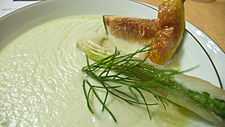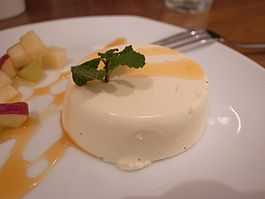Panna cotta
| Panna cotta | |
|---|---|
|
Panna cotta with cream and garnish | |
| Type | Pudding |
| Place of origin | Italy |
| Region or state | Piedmont |
| Main ingredients | Cream, honey, egg white |
| Variations | Cream, milk, sugar, gelatin |
|
| |
Panna cotta (from Italian cooked cream) is an Italian dessert made by blending thick cream, egg white and honey.[1] The blend is then baked in a bain-marie in a low oven. The original panna cotta really does feel and taste like "cooked cream," but requires very careful monitoring of oven temperatures and timing. Alternative recipes, mostly used in restaurants outside of Italy, use simmering together cream, milk, and sugar, mixing this with gelatin, and letting it cool until set. It is generally believed to have originated in the Northern Italian region of Piedmont,[2] although it is eaten all over Italy, where it is served with wild berries, caramel, chocolate sauce, or fruit coulis. It is not known exactly how or when this dessert came to be, but some theories suggest that cream, for which mountainous Northern Italy is famous, was historically eaten plain or sweetened with fruit or hazelnuts. Earlier commercial recipes for the dish did not directly mention gelatin, but instead included a step in which fish bones were boiled; this is now known to extract collagen from the bones, which turns to gelatin. Home preparation has always used honey and egg whites, traditionally abundant in Italian homes, left over from the yolks used to enrich hand-made pasta and cakes. Sugar, later a main ingredient, would not have been widely available as it was an expensive imported commodity. After years this treat evolved, commercially, into what is now a gelatin dessert, flavoured with vanilla and topped with fruit or spices, and served chilled.
Rather similar versions of this dish are found in Greece, France, and Finland.
-

A close-up view of fennel panna cotta
See also
- List of Italian desserts
- Food portal
References
- ↑ Guetta, Benedetta Jasmine. "Panna cotta, la ricetta tradizionale". Labna. Retrieved 7 September 2014.
- ↑ Davidson, Alan (2006). Jaine, Tom, ed. The Oxford Companion to Food (second ed.). Oxford: Oxford University Press. p. 574. ISBN 9780192806819.
